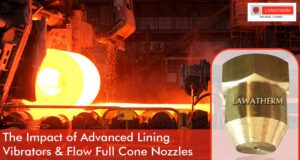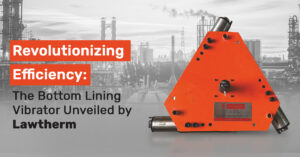Induction furnace lining vibrators play a crucial role during the ramming of refractory material. A well-compacted lining ensures better thermal performance and longer lining life. But like any other mechanical equipment, vibrators too can show signs of trouble. If your 3 arm lining vibrator or 5 arm vibrator is not functioning properly, it can lead to poor lining quality and furnace downtime.
Let’s walk through the most common furnace vibration issues, why they happen, and how to fix them.
1. Vibration Inconsistency
One of the most reported problems is vibration inconsistency. Your vibrator may start strong but lose power midway. Sometimes, the vibration fluctuates without warning.
Why it happens:
- Loose electrical connections
- Worn-out motor brushes
- Faulty control panel
- Irregular voltage supply
What to check:
- Inspect all power cables and terminals. Make sure they are tightly connected.
- Open the motor housing and check brush wear. Replace if needed.
- Monitor incoming voltage. Fluctuations beyond tolerance can damage the vibrator.
- Test the control panel and replace any damaged relays or contactors.
Action tip: Use a multimeter to check voltage at the terminals when the vibrator is running. Irregular readings indicate a power issue.
2. Uneven Compaction
If the refractory lining is uneven after using a 3 arm lining vibrator or 5 arm vibrator, the problem might not lie in the material but in how the vibrator functions.
Why it happens:
- Arms not reaching all points equally
- Improper positioning of the vibrator
- Excessive wear in vibrator arms
- Arms not moving at the same speed
What to check:
- Make sure the vibrator is centered properly inside the furnace shell.
- Measure the length and angle of all arms to ensure symmetry.
- Check for bent, cracked, or loose arms.
- Listen for abnormal sounds during operation—they can signal imbalance.
Action tip: Rotate the vibrator manually before use to detect any stiffness or lag in one of the arms.
3. Overheating of Vibrator Motor
Overheating is another common problem in induction furnace lining vibrator units. Over time, this can damage the motor and shorten its life.
Why it happens:
- Running beyond rated capacity
- Poor ventilation or clogged filters
- Faulty bearings increasing load
- Misalignment in rotating parts
What to check:
- Compare your operation time with the recommended duty cycle.
- Clean motor vents and ensure airflow is not blocked.
- Check bearings for noise and resistance during manual rotation.
- Inspect shaft alignment between the motor and gearbox.
Action tip: Install a thermal cut-off switch to prevent motor burnout due to overheating.
4. Refractory Lining Issues
Not all problems with the induction furnace lining vibrator come from the vibrator itself. Sometimes, the issue lies in the ramming mix or the way it is applied.
Why it happens:
- Improper moisture content in ramming mass
- Use of expired or contaminated material
- Inconsistent ramming technique
- Lining not done in layers
What to check:
- Always check the date of the ramming material.
- Maintain correct water-to-mass ratio.
- Ensure ramming is done in layers of uniform thickness.
- Allow each layer to be compacted thoroughly before adding the next.
Action tip: Take small test batches to ensure correct consistency and compaction before lining the full furnace.
5. No Start or Sudden Stop
If your 3 arm lining vibrator or 5 arm vibrator refuses to start or suddenly stops during operation, you’re looking at either electrical or mechanical failure.
Why it happens:
- Blown fuses or tripped breakers
- Faulty start/stop switch
- Motor windings shorted
- Seized bearings
What to check:
- Replace any blown fuses. Reset tripped breakers.
- Use a continuity tester to check the switch.
- If the motor hums but doesn’t start, test windings for resistance.
- Rotate the motor shaft manually. If it feels stuck, inspect bearings.
Action tip: Always isolate the power supply before opening electrical panels or accessing the motor.
6. Excessive Noise or Vibration
Some amount of vibration is expected—it’s in the name. But if your induction furnace lining vibrator is shaking abnormally or making sharp sounds, it’s time to dig deeper.
Why it happens:
- Loose mounting bolts
- Imbalanced arms
- Worn or misaligned couplings
- Shaft bending
What to check:
- Tighten all mounting hardware.
- Check for any missing or damaged counterweights on the arms.
- Inspect the coupling between the motor and shaft for wear.
- Use a straightedge to check for shaft runout.
Action tip: Set up a preventive maintenance schedule to inspect and correct small mechanical issues before they grow.
Regular Checks Matter
A few routine inspections can go a long way in keeping your induction furnace lining vibrator in good shape. Always:
- Lubricate moving parts at regular intervals
- Keep electrical panels dust-free
- Log performance data like noise level and compaction quality
- Replace worn-out parts instead of waiting for failure
Lawatherm supplies both 3 arm lining vibrator and 5 arm vibrator systems that are built to last. But proper maintenance and timely troubleshooting are what really make them work efficiently in the long run.
Troubleshooting your induction furnace lining vibrator isn’t about guesswork. It’s about observing symptoms, checking possible causes, and acting fast. Whether it’s vibration inconsistency, refractory lining issues, or motor problems, each clue points you toward the fix.
Choose Lawatherm for durable and reliable vibrators that reduce downtime and support a strong refractory lining. Our products are designed to help you keep furnace operations running smoothly, one layer at a time.




